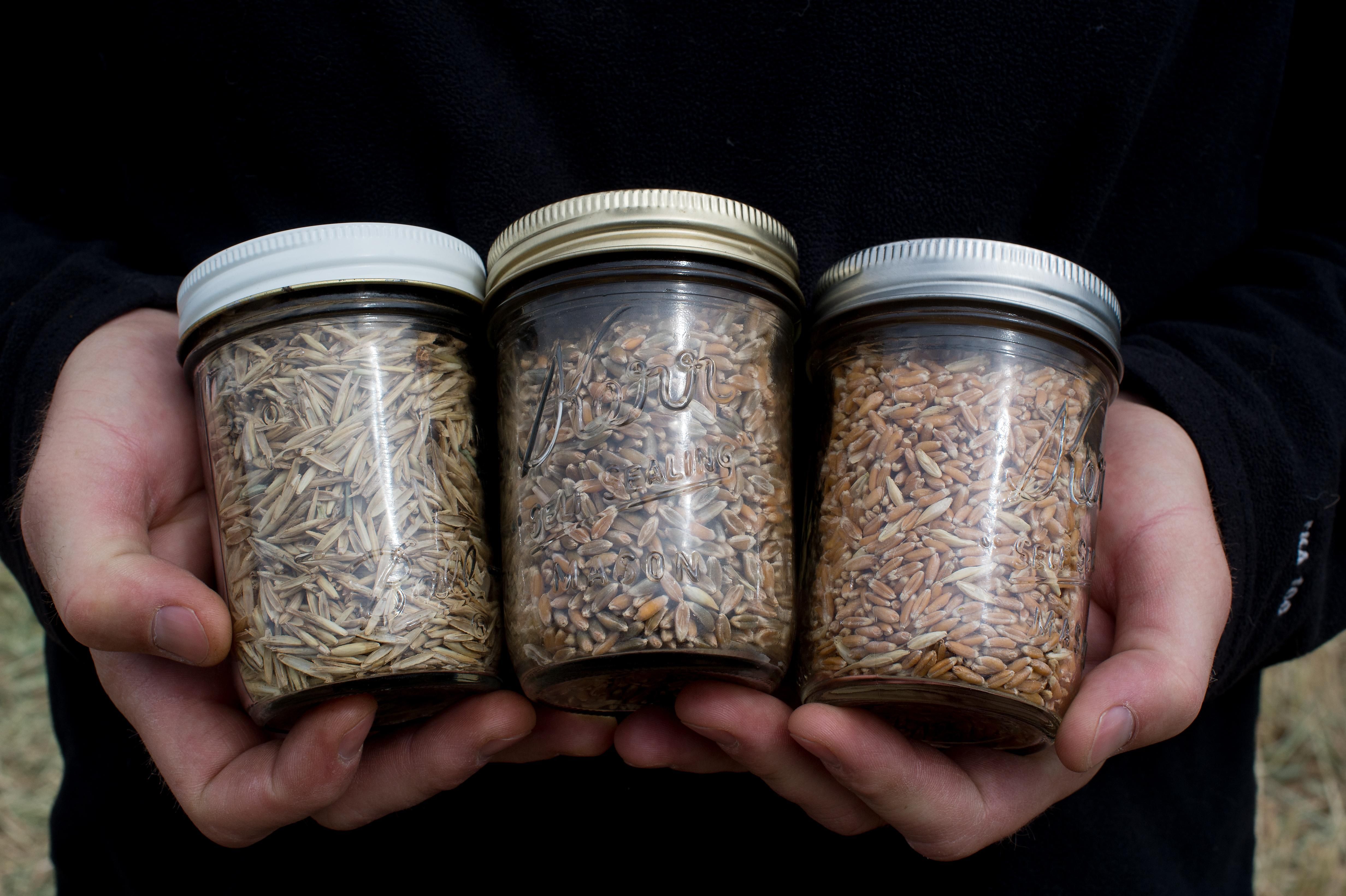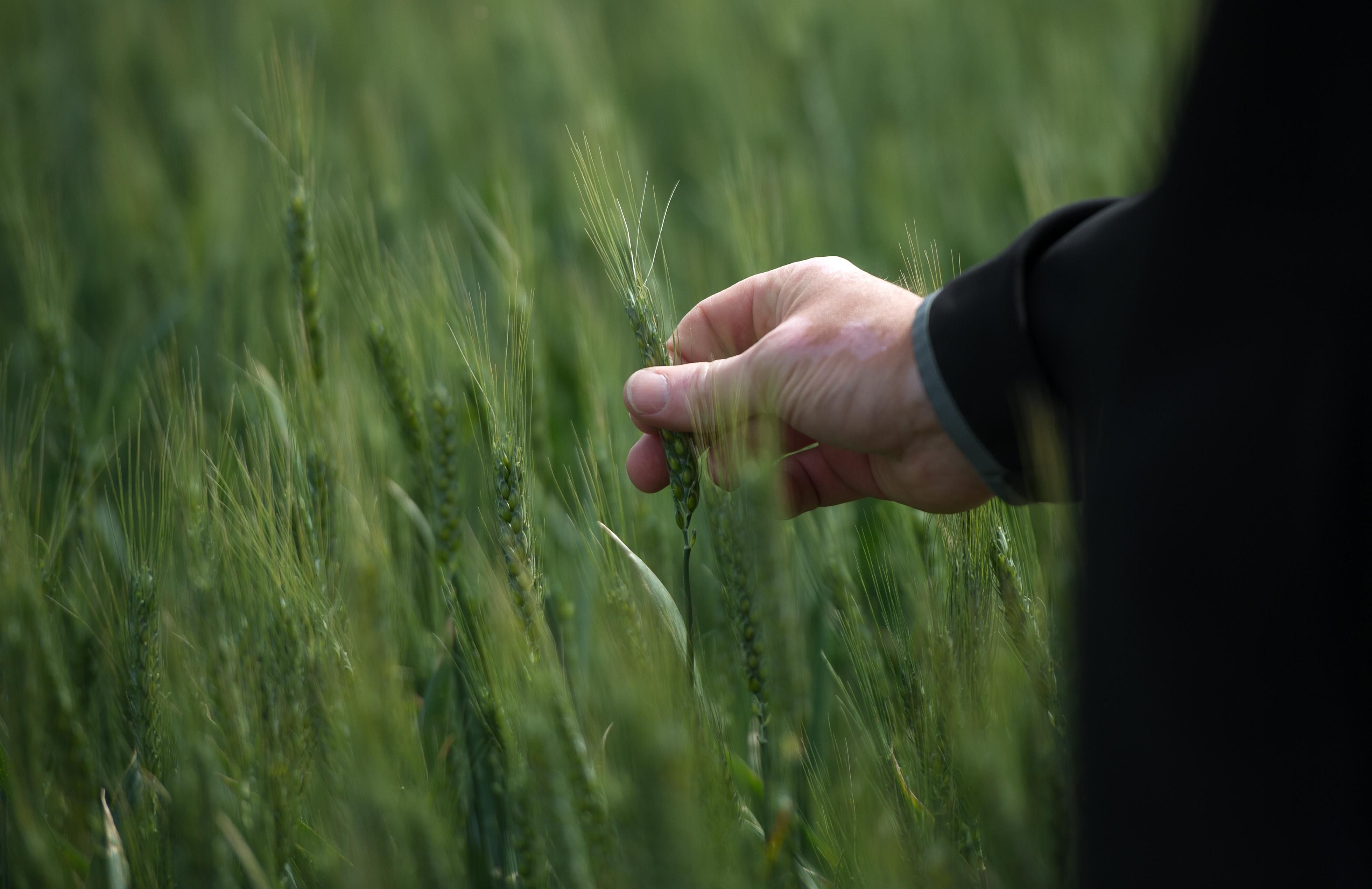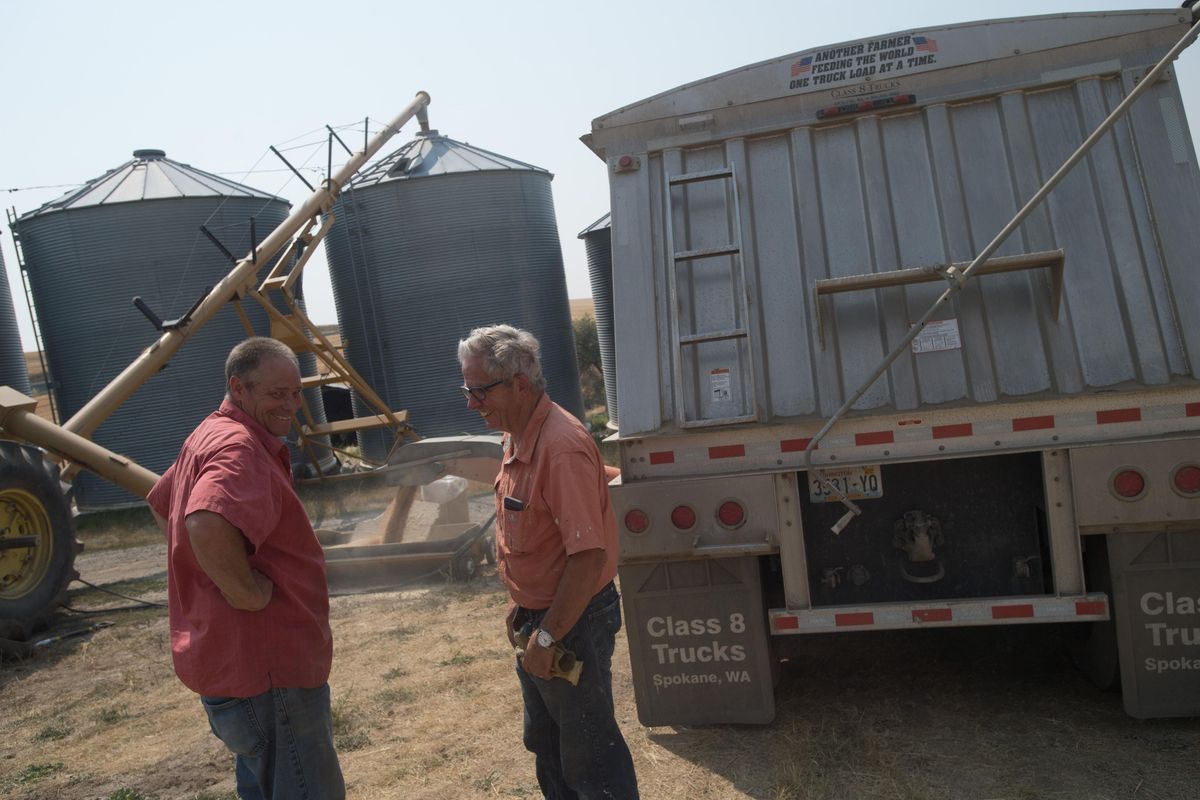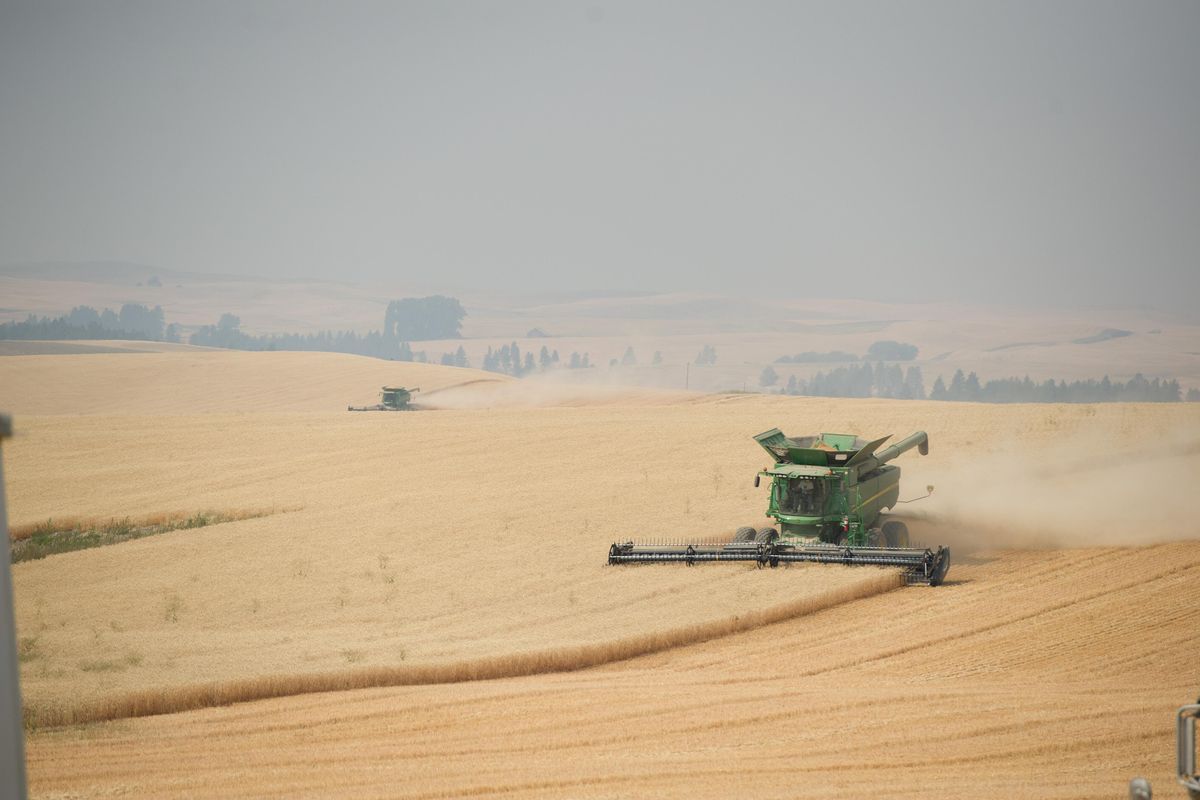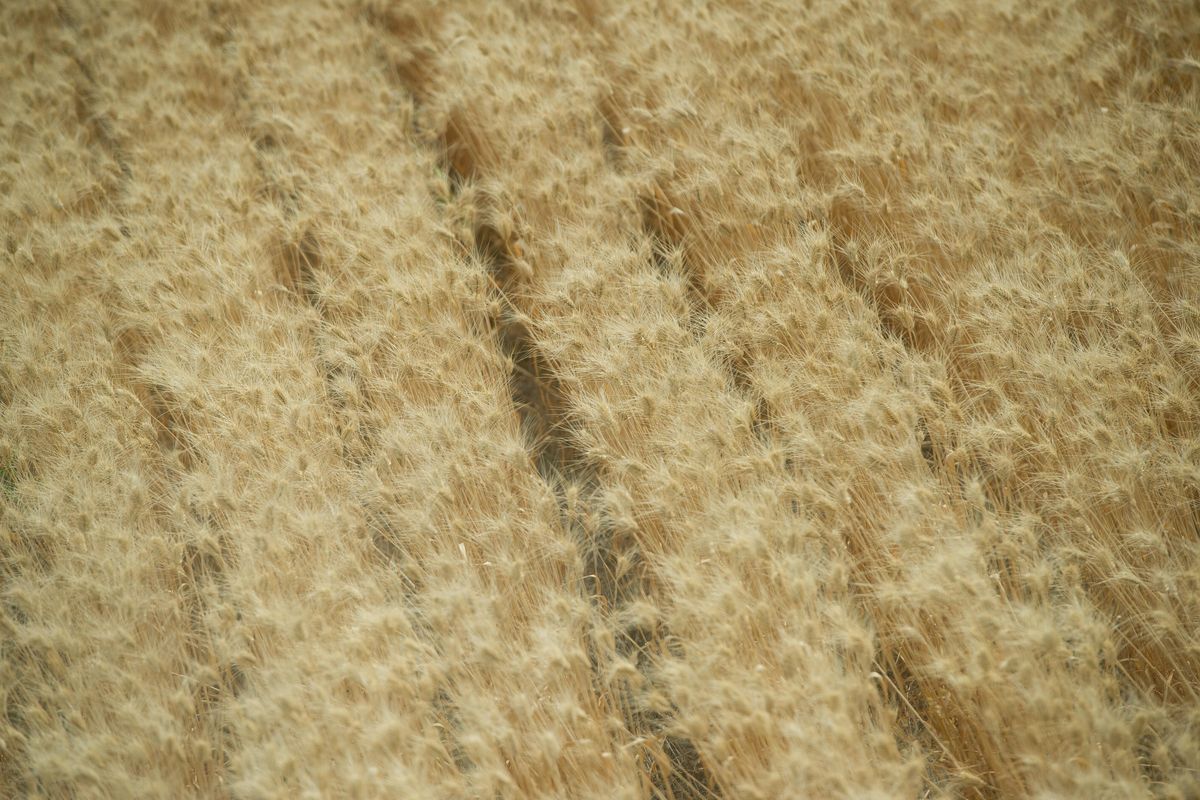The world of wheat: Growing grain in Washington
Sun., July 16, 2017 | By Chad Sokol

The wheels of Bill Myers’ black Jeep flung dust into the air at each bend of the gravel road that winds through his 3,300 acres of hilly farmland northwest of Colfax.
At the end of the road Myers passed a warehouse, where he stores equipment, and the 80-year-old home his grandfather built from a prefabricated Sears kit. Then he trudged through a field of dark northern spring wheat to a bluff overlooking the Snake River, where he swam as a child.
Much of the wheat was still green in early July, but an adjacent field had taken on a warm golden color. Myers, 66, wore a faded gray baseball cap and seemed unperturbed by the afternoon heat. His family has farmed for five generations, and he can’t imagine doing anything else.
“Something gets printed on your DNA when you grow up someplace, and there’s nothing you can do about it,” he said.
Soon it will be harvest time, and Myers will truck most of his wheat to a nearby grain elevator, where it will be blended with wheat from neighboring farms. Much of it will be barged down the Snake and Columbia rivers, or hauled in trains to ports along the coast. From there it might depart to Japan or Egypt or Chile to become noodles or flatbreads or soft loaves called marraquetas.
Wheat is one of Washington’s most valuable farm products, ranked among apples, milk, cattle and potatoes. Roughly 2.3 million acres in the state are put into wheat production each year. The industry employs thousands of Washingtonians and contributes hundreds of millions of dollars to the state’s economy.
Yet farmers say it’s no easy way to make a living. Because up to 90 percent of the state’s wheat is exported, their profits are at the mercy of a competitive global market. And to ensure a good crop, they must constantly protect their plants from diseases and pests – and hope for good weather.
“The farmers that are still around are all pretty good farmers,” said James Moyer, the associate dean for research in Washington State University’s agriculture college. “You have to be good to have survived this long, to have weathered all the storms.”

‘Feeding the world’
Hundreds of wheat varieties are cultivated in the United States, and each falls into one of six market classes, distinguished by their color, shape, hardness and time of planting.
They also vary by the regions in which they’re grown. Soft white winter wheat accounts for about 80 percent of Washington’s crop and is considered a specialty of the Pacific Northwest, while the top wheat-producing states – Kansas, North Dakota and Montana – grow primarily the hard red classes. Soft white varieties are ideal for Asian-style noodles and sponge cakes.
“People may think wheat is wheat is wheat, and might not have an appreciation for the different market classes,” said Craig Morris, the director of the U.S. Department of Agriculture’s Western Wheat Quality Lab in Pullman. “We have sedans and coupes and minivans and SUVs. We have all different shapes and sizes to market to people. It’s very much the same thing with wheat.”
Washington is known not for the quantity of the wheat it produces but for the quality, said Glen Squires, the chief executive officer of the Washington Grain Commission.
Because it’s home to such varied climates and landscapes, the state is capable of producing a diverse wheat crop. Roughly 10 percent is hard red winter and roughly 10 percent is hard red spring. And under the soft white category there is a subclass called club wheat, named for its distinctive stubby head.
The specifications of each variety, such as protein content and gluten toughness, matter greatly to foreign buyers. The United States exports wheat to about 60 countries, with each buyer aiming to suit a regional palate. Some prefer wheat that can be refined into a starchy white flour; others want wheat that mills well as a whole grain.
“We routinely talk to the Japanese,” one of the top consumers of U.S. white wheat, Morris said. “They have zero interest in whole grain wheat. They say, ‘We eat lots of vegetables. We don’t need it. We want white flour.’ ”
The United States produces about 8 percent of the world’s wheat and exports about 46 percent of that, with much of it leaving through ports in Washington and Oregon.
Exports have fluctuated since the early 1960s, topping 48 million metric tons in 1982 and falling below 23 million metric tons in 2003, according to the USDA. In recent years, annual exports have mostly hovered below 30 million metric tons.
Although the country is still a major player in the global wheat market, it has in recent years fallen behind the European Union, Canada and Russia.

The USDA oversees two “market promotion” programs that help sell American crops in foreign countries. They support organizations like U.S. Wheat Associates, which has 15 international offices and works to maintain trade relationships and establish new ones.
In June, Casey Chumrau, who runs U.S. Wheat Associates’ marketing operations in Santiago, Chile, led four Chilean businessmen on a tour of American wheat-producing regions. The group flew from Santiago to Oklahoma City to Sacramento to Spokane, then drove to several destinations on the Palouse, including the USDA lab in Pullman and a grain terminal along the Clearwater River in Lewiston.
The four businessmen represent milling companies in Chile’s central valley and are collectively responsible for purchasing about 60 percent of the country’s 850 thousand metric tons of annual wheat imports, Chumrau said.
Chumrau’s job is to take advantage of Chile’s love for wheat by showing off what the United States has to offer. The average Chilean eats more than 200 pounds of bread each year, she said, placing it among the top per capita wheat consumers in the world. The United States and Canada alternate places as Chile’s top foreign supplier.
“It’s cliché to say that we’re feeding the world, but, you know, it’s actually true,” Morris said.

A hub for wheat science
Archaeological evidence suggests wheat was domesticated as early as 10,000 years ago in the so-called Fertile Crescent region, in a spot that’s now part of Turkey.
It was a primitive variety known as einkorn, which has 14 chromosomes. A 28-chromosome variety, called emmer, was cultivated later, and scientists believe it crossed with a weed, called jointed goatgrass, to create modern wheat’s 42-chromosome structure.
Only in the past few years, however, have gene sequencing and related technologies begun to play a prominent role in wheat breeding, Morris said.
“Applied plant breeding really is an art, and most of it is done in the field,” he said. “Now these genomic technologies are really starting to complement the traditional guy or gal who’s out there in the field, looking at wheat and making selections.”
Breeding is a laborious process that involves numerous rounds of experimentation. Morris said more than 99 percent of the breeds tested are never released, and it can take a decade or longer to develop a variety that can compete in a crowded market.
“It not only has to be good enough for growers,” he said. “It has to be better than what’s out there already.”
Morris’ lab occupies a nondescript building on Washington State University’s Pullman campus, a floor above Ferdinand’s, the popular ice cream parlor and Cougar Gold cheese dispensary. There are other USDA wheat labs in Kansas, North Dakota and Ohio.
To assess the characteristics of each wheat variety that comes through the lab, Morris and his team of scientists bake cookies. Lots of cookies.
Some turn out wide and flat with a slightly crisp, crackled surface. Others don’t spread much in the oven, or there’s something wrong with the flavor or texture. Each cookie is marked with a numbered sticker so the researchers know which kind of wheat it was made with.
The goal, Morris said, is to answer questions such as “What are the genes that make this dough strong but this one weak?” and “What are the genes that make this cake rise but this one flat?”
One of his breeding accomplishments is soft durum wheat – a term that may sound like an oxymoron to many wheat farmers.
With a high protein content and tough gluten strands, ordinary durum is one of the hardest classes of wheat, ideal for making pasta and not much else. But when Morris and his collaborators bred durum with soft white wheat, they created something far more versatile.
Nearly 20 years in the making, soft durum is being grown commercially near Lewiston, and a pizza restaurant in Pullman uses it exclusively for its crusts, Morris said.
“It makes good pizza crust, it still makes excellent spaghetti, and yet you can use it in cookies and scones and things,” he said. “It opens up a whole new range of culinary uses.”

A future for GMO wheat?
With the USDA and WSU breeding programs, Pullman has become a powerhouse in the world of crop science, said Moyer, the associate dean who also oversees the university’s Agricultural Research Center.
Two years ago, WSU released its 100th wheat variety, named “Jasper” after the man who started the school’s breeding program in 1894. It’s a soft white winter variety developed specifically for the regions of Washington that receive 12 to 18 inches of rain annually.
“We have, if not the strongest, one of the strongest research programs anywhere in the world,” Moyer said. “Our breeding programs are second to none.”
Yet the industry has evolved over the past decade as corporations like Monsanto and Syngenta bolster their presence in the region, Morris said.
“When I started here in ’89 it was essentially 100 percent university and USDA breeders,” he said. “Essentially all the varieties were coming out of university programs.”
The influx of private breeding and genetic engineering programs has created a sense of heightened competition, Morris said.
“The university breeders are still working hard, and still putting out varieties, and still being successful. But it certainly has changed the landscape,” he said. “There’s just more players in the game, and there’s certainly more resources being spent on developing new wheat varieties and marketing those varieties.”
Genetically modified organisms are created by copying genes from one plant or animal and inserting them into the DNA of another organism. Most GMO crops are corn and soybeans eaten by livestock or made into processed food ingredients such as cornstarch, soybean oil and high fructose corn syrup.
The seed conglomerates have been experimenting with GMO wheat in the Northwest in recent years, although no modified variety has been approved for consumption by the U.S. Food and Drug Administration, and some foreign buyers are wary of engineered food.
Kimberly Garland-Campbell, a winter wheat breeder who works in the USDA lab, said she doubts the corporations will find a market for GMO wheat that covers the cost of research and development.
“I’m a research scientist,” she said. “If I thought GMO wheat were worth it, I’d be using it.”

A changing industry
In 2012, when the USDA conducted its last agriculture census, the average Washington grain farmer was just shy of 57 years old. Three decades prior, in 1992, the average was younger than 52.
Farms also have become bigger and more commercialized. During that same period, the number of grain farms in the state declined nearly 57 percent, from 5,032 to 2,871, while total acreage remained almost flat.
The number of partnerships and individually owned farms dropped from 3,035 to 1,743, while the number of farms owned by family corporations grew 20 percent to 807.
Other types of corporations owned 25 Washington grain farms in 2012, up from 10 in 1992. The results of the 2017 agriculture census have not yet been released.
Farms are consolidating and farmers are getting older nationwide. Nearly a third of all U.S. farmers are 65 or older, like Bill Myers.
“Things have gotten awful centralized,” he said. “It used to be everyone was involved in agriculture. It used to be a man could make a living on half a section, and then it was a section, and then it was 1,000 acres …”
The world market determines how much grain companies will pay Myers for a bushel of wheat, and what specifications it should meet.
Last year, many farmers on the Palouse were hit by a plague of low “falling numbers” – a system that measures the presence of an enzyme that degrades starches. Wheat with falling numbers less than 300 is generally considered unsuitable for baking, as it produces breads and cakes that don’t rise properly. And foreign buyers won’t pay full price for unhealthy wheat.
“The system is not geared to our best interest as a grower,” Myers said.
Low falling numbers are a product of bad weather, specifically high daytime temperatures followed by sharp drops at night. Morris, with the USDA lab, said it remains to be seen whether the problem will strike again this harvest season.
Due primarily to a global wheat surplus, the average price per bushel in Portland has tumbled from more than $8 in 2012 to less than $5 this year.

With the rising cost of equipment and maintenance, the average farmer in the state needs about $6 per bushel to break even, said Michelle Hennings, the executive director of the Washington Association of Wheat Growers.
“We have no way of passing on that cost to the consumer as you would do with other commodities,” she said.
The age of the farmers and the consolidation of farms go hand in hand, Hennings said. When younger generations look at their parents’ farms and see little opportunity for profit, she said, “what’s left for the farmer to do but sell?”
And, Hennings said, small wheat farmers and their families are increasingly embarking on other entrepreneurial ventures to balance their checkbooks.
“You don’t see the farmer’s wife staying home anymore,” she said. “You see them working more to help supplement the income.”
Around the time of the recession, Myers recruited his two daughters – one with degrees in agribusiness and marketing, the other with a degree in accounting – to launch a business selling the best of his crops across the Inland Northwest.
Through that business, called Joseph’s Grainery, the family can get up to $60 for a bushel of wheat, more than 10 times what they would make by offloading it at the local elevator.
Myers doesn’t know if his daughters will take over the family farm, but he doesn’t plan to sell it anytime soon.
“I’ve looked at retirement from afar,” he said. “I’m unimpressed.”
Editor’s note: This story was changed on July 17, 2017. A previous version incorrectly stated how many metric tons of wheat are imported to Chile each year.